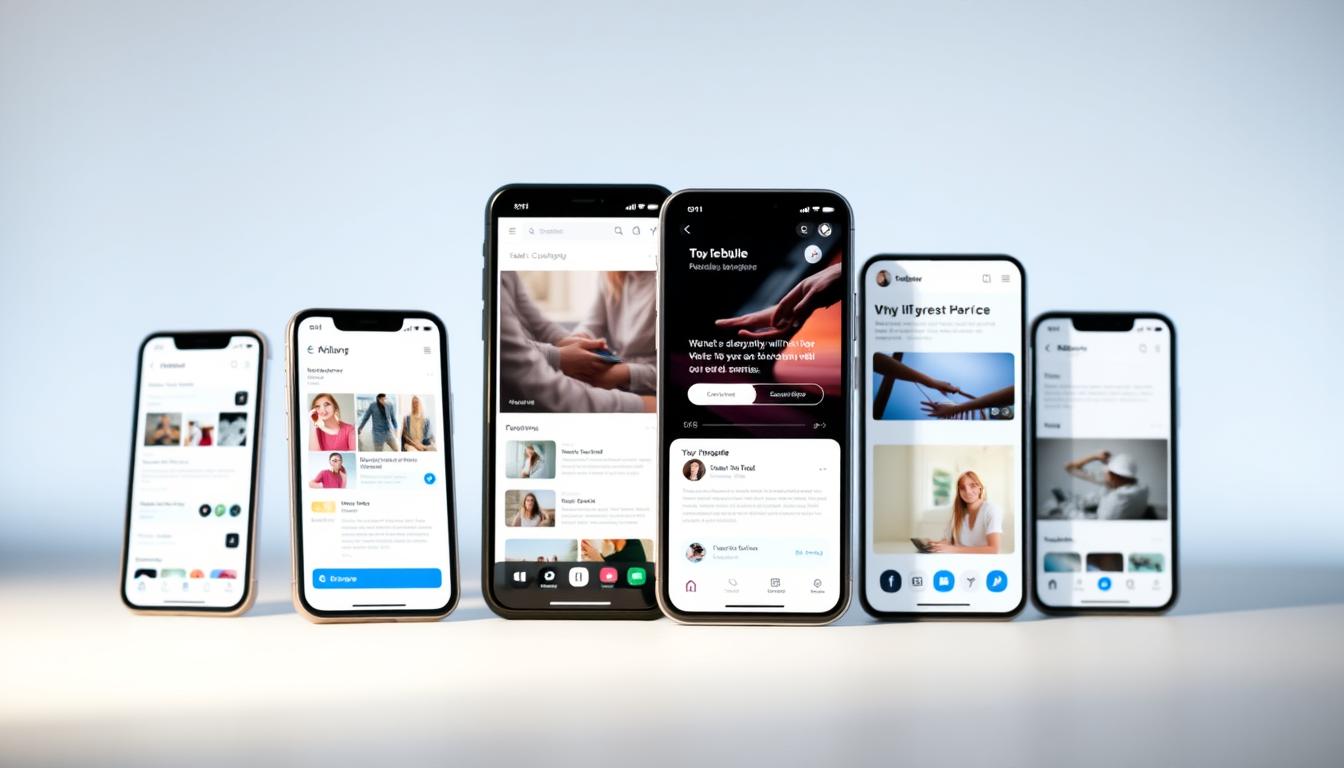In today’s digital landscape, mobile devices dominate internet usage. With over 60% of web traffic coming from mobile devices, optimizing your website is no longer optional.
Google’s mobile-first indexing means that a non-mobile-friendly website risks poor search rankings. Creating a joyful user experience is crucial, as it’s not just about technical adjustments, but about converting visitors into customers.
Key Takeaways
- Mobile devices account for over 60% of web traffic.
- Google’s mobile-first indexing prioritizes mobile-friendly websites.
- A mobile-friendly website is crucial for search engine rankings.
- Creating a joyful user experience is key to converting visitors.
- Mobile optimization is essential for businesses.
Why Mobile Optimization Matters in 2024
As we dive into 2024, it’s clear that mobile optimization is no longer a luxury, but a necessity for any website aiming to stay relevant. With the digital landscape evolving rapidly, a mobile-first design has become the cornerstone of a successful online presence.

The Mobile-First Reality
The way people access the internet has undergone a significant shift, with 84% of people now owning smartphones and using them as their primary device for internet access. This mobile-first reality has transformed the digital landscape, making it imperative for businesses to prioritize mobile optimization. Google’s focus on mobile-first indexing reflects this shift, prioritizing the mobile version of your site for ranking purposes.
How Mobile Performance Impacts Your Business
A site that offers a poor user experience on mobile devices risks losing visitors and, more importantly, relevance. On the other hand, a well-optimized site can significantly boost conversion rates, as seen in the case of GreenPal, where mobile conversion rates jumped from 4% to 82% after implementing a mobile-first design. Mobile performance metrics have become critical ranking factors, directly impacting your visibility in search results. By focusing on mobile optimization, businesses can improve their search engine rankings, drive more traffic, and ultimately enhance their bottom line.
Understanding Mobile User Behavior
Understanding how mobile users behave is crucial for creating a seamless online experience. Mobile users have different expectations and behaviors compared to desktop users, and understanding these differences is key to optimizing your website.
What Mobile Users Expect From Your Website
Mobile users expect a smooth and efficient experience when visiting a website on their devices. They anticipatequick load times, easy navigation, and content that’s easy to read on small screens. To meet these expectations, it’s essential to understand how mobile users interact with your website. People typically scan content rather than read in-depth, requiring different content presentation strategies. By understanding these behaviors, you can create a more intuitive and user-friendly experience for your visitors.
Common Mobile Usability Pain Points
Despite the growing importance of mobile optimization, many websites still struggle to provide a seamless experience for mobile users. Common pain points include slow loading times, difficult navigation, and content that’s hard to read on small screens. To avoid these issues, it’s crucial to identify the most common frustrations mobile users experience, such as tiny tap targets, excessive scrolling, and poorly optimized content. By understanding these pain points, you can design a more user-friendly experience for your mobile users.
To enhance the user experience, consider the context in which mobile users access your site. They might be commuting, in stores, or in other environments that require a different approach to navigation and content consumption. By understanding these factors, you can create a more intuitive and engaging experience for your mobile users.

In conclusion, understanding mobile user behavior is vital for creating a website that meets the needs of your mobile visitors. By recognizing their expectations and pain points, you can design a more user-friendly and engaging experience that drives conversions and boosts your online presence.
Implementing Responsive Design for Mobile Users

Responsive design is no longer a luxury, but a necessity for websites aiming to cater to diverse screen sizes and devices. In today’s digital landscape, where mobile traffic leads the way, a responsive website ensures that your online presence is robust and accessible across various platforms.
Mobile-First vs. Desktop-First Approach
When implementing responsive design, one crucial decision is whether to adopt a mobile-first or desktop-first approach. Starting with a mobile-first strategy allows you to prioritize content and functionality, leading to a more streamlined and efficient design. This approach focuses on the constraints of smaller screens, ultimately resulting in a better overall user experience.
CSS Media Queries and Breakpoints
CSS media queries are fundamental to responsive design, enabling you to control how content displays at different screen sizes. By defining breakpoints, you can specify when the layout should adapt to accommodate various devices, ensuring an optimal viewing experience. For instance, you might set breakpoints for smartphones, tablets, and desktops, adjusting the layout accordingly.
Flexible Grids and Images
A key aspect of responsive design is the use of flexible grid systems that maintain proportional layouts across devices without relying on fixed pixel dimensions. Additionally, handling images responsively involves techniques such as using fluid images and the picture element to serve different image versions based on the device’s screen size and resolution.
By embracing responsive design principles, you can create a website that not only adapts to any screen size but also provides an optimal experience for users across various devices. This involves a thoughtful approach to design, leveraging tools like CSS media queries, flexible grids, and responsive images to ensure your site is accessible and engaging for all users.
How to Optimize Website for Mobile Users
A mobile-optimized website is crucial for providing a good user experience, and it starts with simplifying navigation for small screens. As the majority of web traffic comes from mobile devices, ensuring that your website is accessible and easy to navigate on these devices is paramount.
Simplifying Navigation for Small Screens
Simplifying navigation for mobile users involves several key strategies. First, consider using a hamburger menu to hide navigation options until they’re needed, reducing clutter on small screens. Priority navigation is another technique, where the most important pages or actions are prominently displayed, while less critical items are hidden or placed further down the page.
Bottom navigation bars are also gaining popularity as they are easily accessible with thumbs, making it simpler for mobile users to navigate your website. When designing navigation, make sure it’s intuitive and doesn’t require too much scrolling or tapping.
- Use hamburger menus or collapsible navigation to save screen space.
- Prioritize key pages and actions in your navigation.
- Consider bottom navigation bars for thumb-friendly access.
Creating Touch-Friendly Elements
Creating touch-friendly elements is vital for a good mobile experience. Ensure that buttons and links are large enough (minimum 44×44 pixels) and have enough space around them to prevent accidental taps. This not only improves the user experience but also reduces frustration when interacting with your website on a small device or different different devices.
Forms should also be optimized for mobile, with input types that are easy to interact with on a touchscreen. Minimizing the amount of typing required can significantly enhance the user experience. Additionally, avoid using interstitials or pop-ups that can be intrusive and are penalized by Google, further emphasizing the need to optimize your website for a seamless mobile experience.
- Size touch targets appropriately (at least 44×44 pixels).
- Ensure adequate spacing between touch targets to prevent errors.
- Optimize forms for mobile by using appropriate input types and minimizing typing.
Testing your website across different devices and screen sizes is crucial to ensure a consistent and positive experience for all mobile users. By simplifying navigation and creating touch-friendly elements, you can significantly enhance the usability of your website on mobile devices.
Improving Mobile Page Speed
In today’s digital landscape, a fast-loading mobile website is no longer a luxury, but a requirement. With the majority of users accessing websites through mobile devices, optimizing mobile page speed has become crucial for a better user experience and improved search engine rankings.

Choosing Better Web Hosting
One of the most important things you can do to improve your site’s mobile SEO is to improve the site’s loading speed. Investing in better web hosting is the number one tip to optimize the speed of your mobile site. Budget shared hosting options can significantly slow down your site, impacting user experience and search engine rankings.
Image Optimization Techniques
Optimizing images is critical for improving mobile page speed. Techniques include proper sizing, using compression tools, and adopting next-gen formats like WebP. By optimizing images, you can significantly reduce file sizes, leading to faster loading times and a better user experience.
Minifying Code and Reducing HTTP Requests
Minifying CSS, JavaScript, and HTML can significantly reduce file sizes and HTTP requests, leading to faster page loading times. By streamlining your code and reducing the number of requests, you can improve your site’s overall performance and user experience.
Browser Caching and Content Delivery Networks
Implementing browser caching and using Content Delivery Networks (CDNs) can dramatically improve loading times. Browser caching allows frequently-used resources to be stored locally, reducing the need for repeat requests. CDNs distribute your content across different geographic locations, reducing the distance between users and your site’s resources.
By implementing these strategies, you can significantly improve your mobile page speed, enhancing user experience and search engine rankings. Core Web Vitals metrics will help identify specific speed improvements that matter most to users and Google.
Content Optimization for Mobile Screens
Optimizing content for mobile screens is crucial for a seamless user experience. With the majority of users accessing websites through mobile devices, it’s essential to prioritize content that matters most to them.
Prioritizing Important Content
When it comes to mobile screens, it’s vital to focus on the most important content. This means prioritizing key information and breaking it down into easily digestible chunks. To achieve this, consider the following:
- Identify the main message you want to convey
- Use clear and concise headings
- Break up content with subheadings and bullet points
Typography and Readability Best Practices
Typography plays a significant role in mobile readability. To ensure a smooth reading experience, follow these best practices:
- Use a minimum font size of 16px
- Choose a clear, legible font
- Maintain sufficient contrast between text and background
Make sure to test your typography across different devices and lighting conditions to ensure universal accessibility.
Optimizing Videos and Interactive Elements
When it comes to videos and interactive elements, optimization is key. To ensure a smooth experience, consider the following:
- Properly size and compress videos for mobile
- Provide captions for videos
- Ensure interactive elements like maps, sliders, and forms work well on touchscreens
By following these best practices, you can create a mobile-friendly experience that engages users and drives conversions.
Mobile SEO Best Practices
In today’s mobile-first world, optimizing your site for search engines on smaller screens is not just a nicety, but a necessity. As we navigate the complexities of mobile SEO, it’s essential to understand the strategies that can improve your site’s visibility and ranking on search engines.

Structured Data for Mobile Pages
Structured data is crucial for helping search engines understand your content. By incorporating schema markup into your mobile pages, you can enhance your site’s visibility in search results. Ensure that your mobile site has the same structured data as your desktop version to avoid confusing search engines and to potentially benefit from rich results.
Avoiding Common Mobile SEO Mistakes
Common mistakes such as blocked resources, unplayable content, and faulty redirects can significantly hinder your mobile SEO efforts. Regularly audit your site to identify and fix these issues, ensuring a smooth user experience across all devices.
Google’s Mobile-First Indexing Requirements
With Google’s mobile-first indexing, the search engine prioritizes the mobile version of your site when indexing and ranking. Ensure that your mobile site is fully optimized by having the same content as your desktop site, along with properly implemented structured data and fast loading speeds.
By following these mobile SEO best practices, you can improve your site’s search engine rankings, drive more traffic, and provide a better user experience for your mobile users. Whether it’s optimizing title tags, meta descriptions, and URLs for mobile search results or focusing on local SEO for users searching for nearby businesses, every detail counts.
To further enhance your mobile SEO strategy, consider leveraging tools designed for mobile SEO analysis and optimization. These can help identify areas for improvement and provide insights into how to better optimize your site for mobile users.
Testing Your Mobile Website
Testing your mobile website is a critical step in optimizing user experience. Regular testing helps identify issues early in the mobile optimization process, ensuring a smooth and efficient user experience across various devices and browsers.

Using Google’s Mobile-Friendly Test
Google’s Mobile-Friendly Test tool is a valuable resource for evaluating your website’s mobile compatibility. By using this tool, you can identify areas that need improvement to ensure a seamless user experience on mobile devices. It’s a straightforward process that provides actionable insights to enhance your website’s mobile performance.
Core Web Vitals and Page Experience Metrics
Core Web Vitals metrics, including Largest Contentful Paint (LCP), First Input Delay (FID), and Cumulative Layout Shift (CLS), measure real-world user experience on mobile devices. These metrics provide insights into your website’s performance, helping you optimize for better user engagement and search engine rankings.
Testing Across Different Devices and Browsers
To ensure consistent experiences across various platforms, it’s essential to test your website on multiple devices, operating systems, and browsers. This comprehensive approach helps identify and address compatibility issues, providing a smooth user experience regardless of how visitors access your site.
Additional tools like Lighthouse and PageSpeed Insights offer actionable recommendations to further optimize your website’s mobile performance. By leveraging these tools and Google Search Console, you can monitor mobile usability issues and track improvements over time, ensuring your website remains competitive in the ever-evolving digital landscape.
Conclusion
The importance of mobile optimization cannot be overstated, as it directly impacts both user experience and search engine rankings.
In summary, optimizing your website for mobile users involves several key strategies, including implementing responsive design, improving page speed, and creating touch-friendly elements.
By prioritizing these optimizations, you can significantly enhance the experience for your users, leading to better engagement and ultimately, improved business results.
Remember, mobile optimization is an ongoing process that requires regular testing and refinement to stay competitive in an increasingly mobile-first world.
Start by focusing on high-impact optimizations like speed improvements and responsive design to see immediate results.










